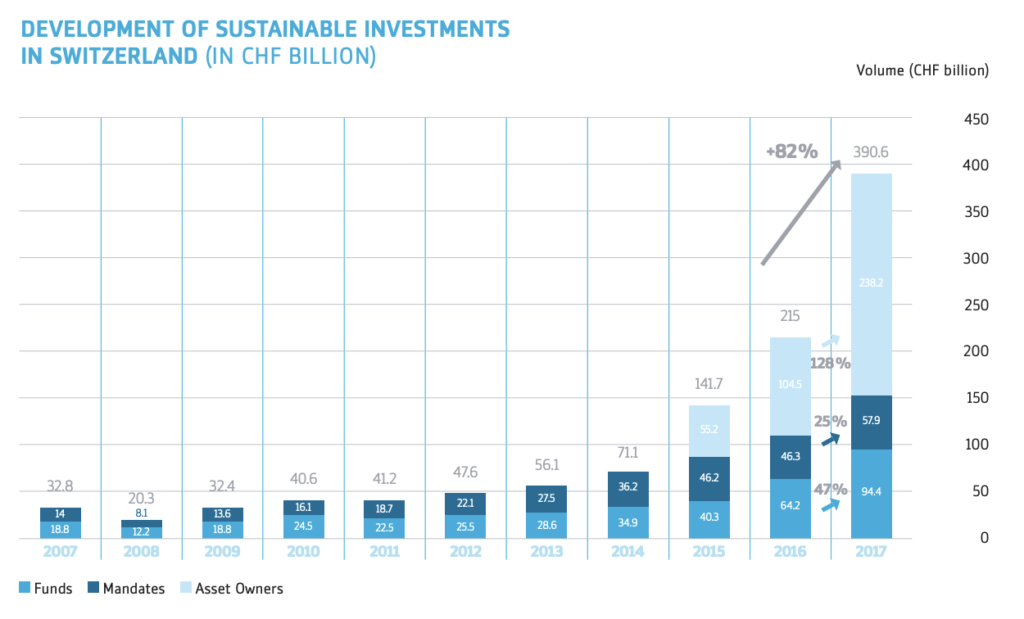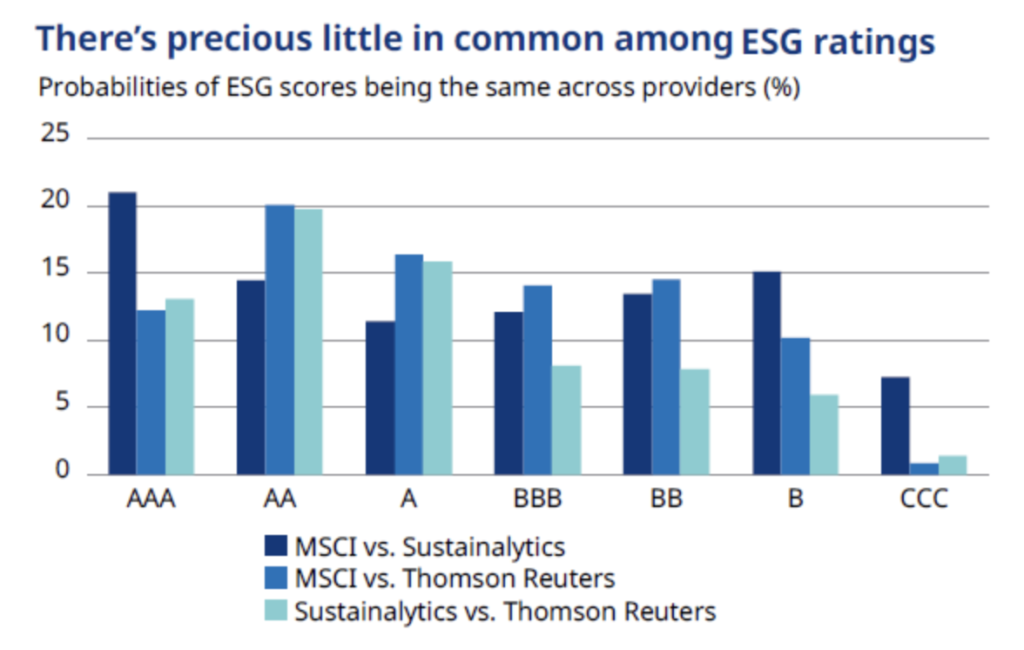ESG – Environmental, Social and Governance
“The financial sphere has reached a size far beyond what is required to support the real economy and, as such, is a source of volatility (…). [It] is able to attract a huge amount of capital which could flow into the real economy to create real solutions to the current challenges, for example, those within the environment.”
Marc Chesney, Professor of Quantitative Finance at the University of Zurich, p.25, KPMG and WWF 2012[1]
Enough evidence exists to show that a commitment to sustainability from the financial sector could lead to huge positive impact in climate change and social issues, as well as help to rebuild public trust in the financial sector.
Sustainable investments
ESG data is used to allocate capital via ESG investment strategies, which are known as sustainable investments.
In recent years, there has been a substantial increase in sustainable investments in Switzerland.[2]
These investments have led and will continue to lead to new regulations in sustainability and related areas.
[1] KPMG and WWF Switzerland, Environmental performance of Swiss banks: Shifting gears towards next generation banking (KPMG Advisory NV and WWF Switzerland, the Netherlands).
[2] Swiss Sustainable Finance (2018): https://www.sustainablefinance.ch/upload/cms/user/SSF_Swiss_Sustainable_Investment_Market_Study_2018_E_final1.pdf
One such example of new regulations is the 2018 EU action plan on sustainable finance[1]. The aim of the action plan is to:
- Introduce a classification for sustainable activities
- Establish standards and labels for “green” financial products
- Improve risk management through the detection of environmental risks
- Clarify institutional investor duties
- Enhance non-financial information disclosure
ESG reporting
ESG data must first be disclosed by companies to investors so that the investors may use it when deciding where to make their investments.
The disclosure of ESG data normally takes the form of an ESG report, which is a type of corporate sustainability report that has a focus on investor’s needs.
ESG investment strategies
In what way do Swiss banks integrate ESG factors into their asset management?
With investors increasingly taking sustainability data into account during their investment processes[2], the above question, posed by the author as part of the University of Zurich’s 2019 expo on sustainability, led to in-depth research and analysis of five Swiss banks’ investment processes with regard to public investment funds.
The following key conclusions could be drawn:
- Swiss banks use different sustainable investment strategies, or combinations of them, for different funds. All banks restrict the sphere of their sustainable investments by applying negative criteria (e.g. controversial weapons or corruption). Sometimes these negative criteria are used across all asset classes (asset overlayer) and sometimes even for the determination of non-specific sustainable investments.
- The implementation process of the sustainable investment strategies is not very transparent, making it difficult to measure a product’s real impact.
- Applied methodologies across the banks are very heterogenous; therefore, the comparison of services and products is difficult.
- All banks integrate external ESG raw data and external ESG ratings into their investment decision process.
- Sustainability data is often of a qualitative nature. There is not one approach on how to quantify it, raising the question as to whether quantifying should be the goal.
The conclusion made under point 4 is one of the most pivotal as it shows the importance of managing corporate-specific ESG data via ESG reporting.
[1] European Commission (2019): https://ec.europa.eu/info/business-economy-euro/banking-and-finance/green-finance_en
[2] Forum Nachhaltige Geldanlagen, 2019: https://www.forum-ng.org/images/stories/Publikationen/fng-marktbericht_2019.pdf
In the process of allocating capital towards a “sustainable investment”, seven key strategies[1] have been identified:
More information on these strategies can be found here.
ESG rating
It is now generally agreed that a company’s value includes not only the traditional ‘hard’ factors, such as financial prowess, but has also come to include ‘soft’ factors such as social and environmental impact. In order to understand the value of the latter, third-party rating providers evaluate the company’s sustainability and provide an ESG score, which is then used by investors to determine if and how much capital they should allocate to ESG-related investments.
The rating provider applies its methodology to the company and summarizes the environmental, social and governance outcomes to determine the company’s total ESG score. As there are multiple rating providers which use a variety of different methodologies, the ESG scores for the same company may vary depending on the provider. A study completed by Schroders in 2017 shows that the probability of a company’s ESG scores being the same across providers is very low, which highlights the diversity of methodologies used.
[1] Eurosif (2019): http://www.eurosif.org/responsible-investment-strategies/
This underlines the importance of having access to accurate ESG ratings and to the value of true corporate sustainability data. It also leads back to the action point 5 under the EU action plan on sustainable finance – enhancing the disclosure of non-financial information – and underlines the necessity of this research project.
Rating agencies and other financial actors use questionnaires to access ESG data that is not available on a company’s website or in a sustainability report. However, one often gets the impression that rating agencies often do not consider the information in the existing and available documents. Rather, it appears that Swiss banks are flooded with ESG data questionnaires of different types (Word documents, Excel documents, or online logins).
Aim of the research project
This research project aims to optimize the corporate disclosure of ESG data in a sustainability report and the process of data transmission. Therefore, the data needed by rating agencies and other financial players to draw a picture of a company’s sustainability will be analyzed. After the identification of the relevant topics for ESG reporting and technical properties of the data, the findings will be integrated into an existing sustainability reporting standard, the GRI Standards.




